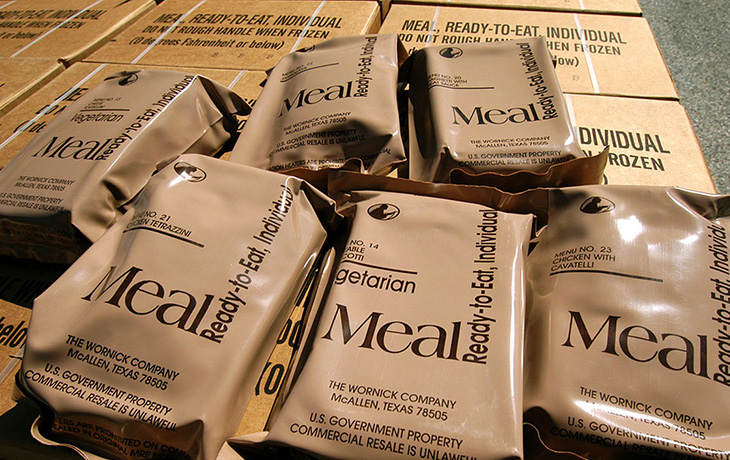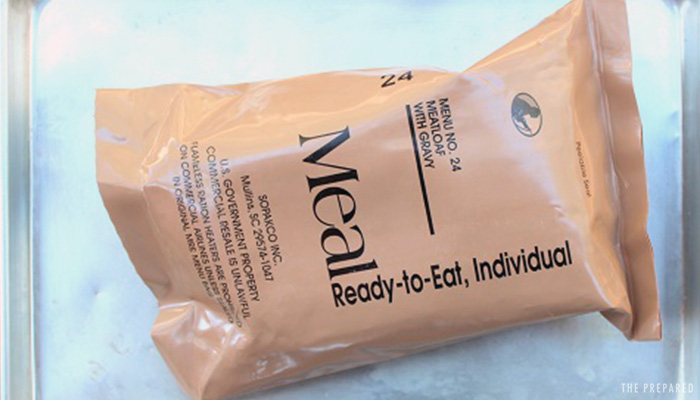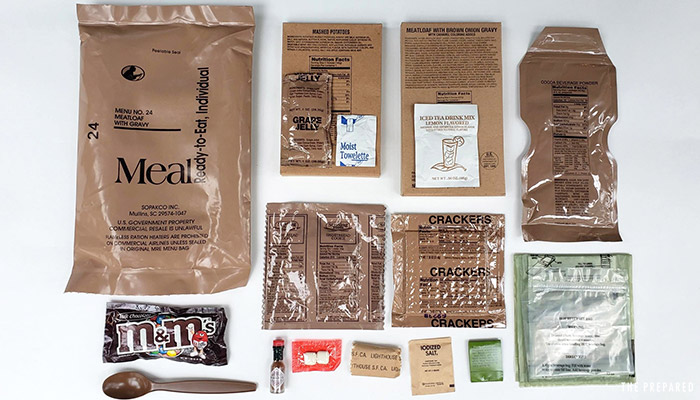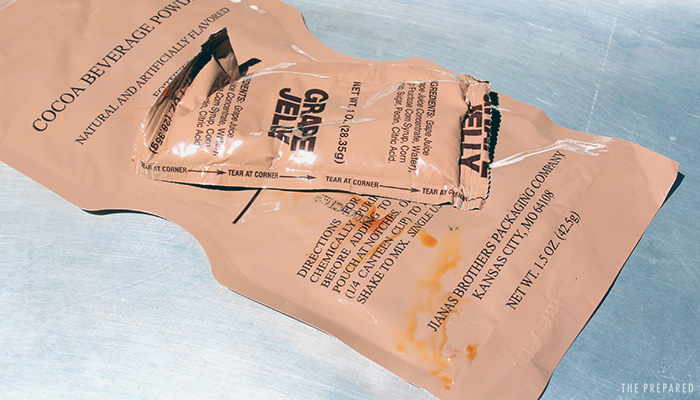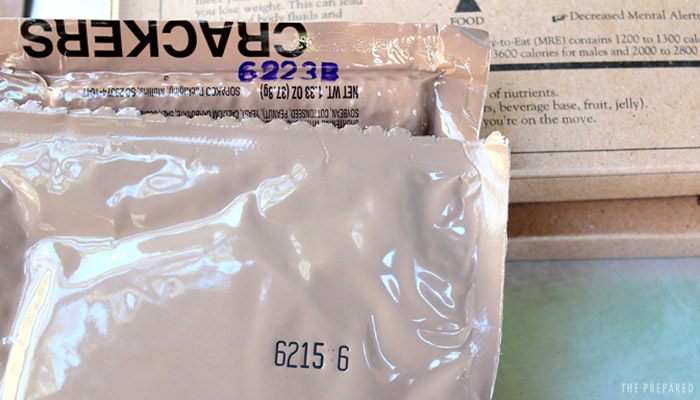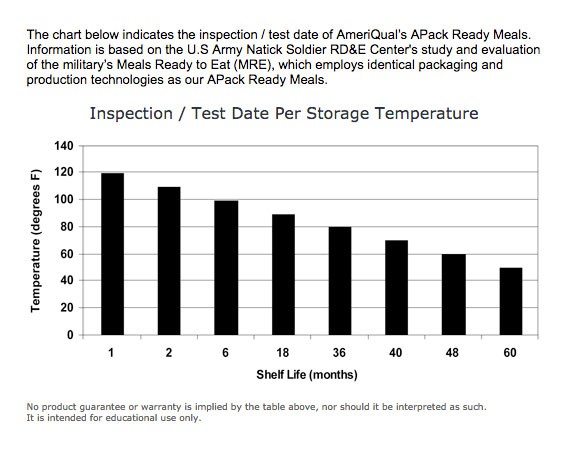There’s nothing particularly wrong with MREs — they are still the standard for mobile militaries and make sense in those scenarios.
But when experts compare them against other types of food you could use to fill the “portable, durable, long shelf life, nutritionally complete, and easy to cook” role for civilian prepping, they tend to fall a little short. A kind of “jack of all trades, master of none” issue.
Unless you have a specific reason to make MREs a part of your prep, it’s generally better to use freeze-dried products like Mountain House, solid “lifeboat” rations like Datrex, or similar DIY options. Those options tend to be a little cheaper, lighter, more calorie dense and compact, last longer, have more meal variety, etc. One of the few benefits of an MRE over some of those products is that the MRE pouch might be more durable.
More: Review of small freeze-dried food buckets and how to make hardtack (lasts longer than MREs)
For example, freeze-dried food will often last for 20-30 years compared to five for an MRE — and they typically weigh and cost less per calorie, too. Or, to get nit picky, many people don’t need to carry the plastic spoon found in each MRE because they already have a washable titanium spork in their go-bag.
The important stuff:
- The best MRE is less about product A vs. product B and more about buying your MREs from a reputable source.
- MREs last about 3-5 years, although if they are stored well, you might be able to stretch that to 10+ years.
- One MRE usually equals 1,250 calories, broken down as 13% protein, 34% fat, and 53% carbs. Active soldiers will consume three a day, although a less active civilian could survive on one or two per day.
- They’re pre-cooked and can be eaten hot or cold (which is why some are sold without water-activated heaters).
- There’s only a handful of menu options. And unless you buy in bulk or have a friendly hookup, you usually won’t be able to pick your meal flavors.
- So your choices come down to normal, options made specifically for freezing climates, vegetarian, low-sodium, and Kosher / Halal.
- Proper MREs are stamped with a four-digit “Julian Date Code.” The first digit is the most-recent matching year, and the latter three are the day of the year. For example, 6224 would mean the 224th day of 2016, or August 11, 2016.
- If it doesn’t have a date code, don’t buy it! If you already have it and there’s no code, then treat it as a bonus, not a dependable part of your preps.
- MREs usually weigh 18-26 ounces (1.1-1.6 pounds).
Many of the MREs you find for sale on sites like eBay were originally made for the military. While military meals technically aren’t for resale, they often “fall off the truck”, are marked for destruction yet get taken home, or take some other path to end up on the surplus market.
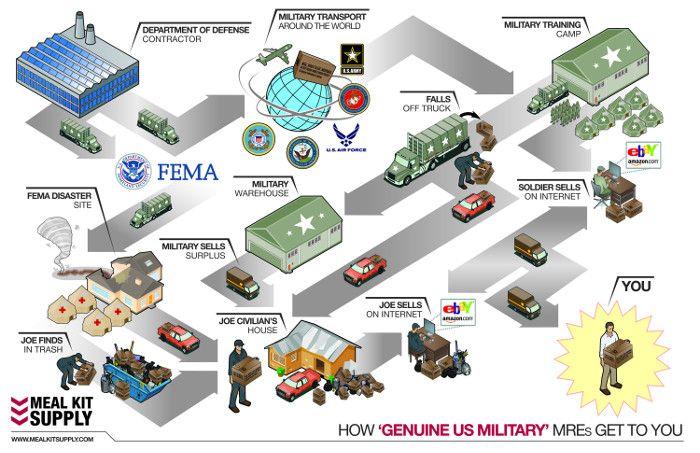
A major problem with those listings is that you have no idea what condition the product is in or how much shelf life is remaining. Many vendors lie. It’s unfortunately common that people buy an MRE and find out it’s already expired or has only 1-2 years left.
Situations like COVID-19 show why this secondary market exists — people panic and pay upwards of $25 per meal, compared to an average $8-9 base cost (if the seller even bought it to begin with.)
Since you want to have confidence in your food supplies, we recommend only buying the civilian versions offered by the same companies that make the official MREs for the US Military.
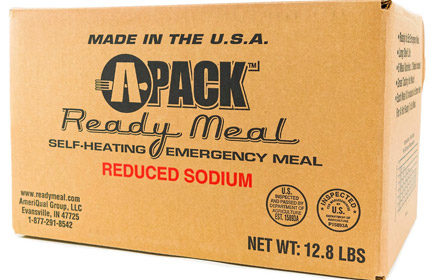
AmeriQual APack
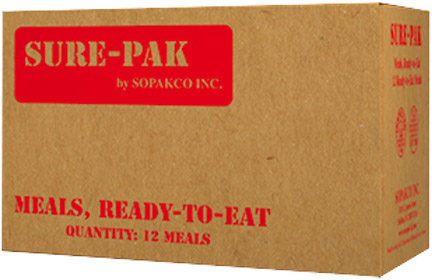
Sopakco Sure-Pak
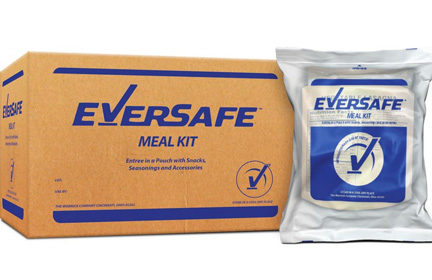
Wornick EverSafe
There are a few additional vendors you can likely trust because they have special relationships with the Big Three makers (or the Big Three’s subcontractors) to either re-label the exact same products listed above or, in some cases, offer non-standard menu options.
- Meal Kit Supply is great for Canadian readers, plus they offer some additional menus including breakfast.
- MRE Star doesn’t supply the US Military, but the US Defense Logistics Agency and other government agencies will sometimes buy their products for disaster relief and law enforcement.
- XMRE is a great source for Kosher and Halal options. They also offer modified versions: “Blue Line” with stripped down packaging and 1,000-1,200 calories for a lighter overall package, and vice versa, the “XT” series with a few hundred more calories than normal.
Some of those vendors will also sell individual components in bulk (eg. lemonade beverage mixes), in case you want to throw a really awesome party after SHTF!
- History
- What’s inside a MRE
- Where to buy MREs (and why you shouldn’t buy surplus)
- How long do MREs last?
- Storage tips
- How to figure out when it was made
- What happens if you are in a terrible situation and come across an old case?
- Meals Ready to Eat are not meant for the long term
- How do they taste?
- Special types
Be prepared. Don’t be a victim.
Want more great content and giveaways? Sign up for The Prepared’s free newsletter and get the best prepping content straight to your inbox. 1-2 emails a month, 0% spam.
History
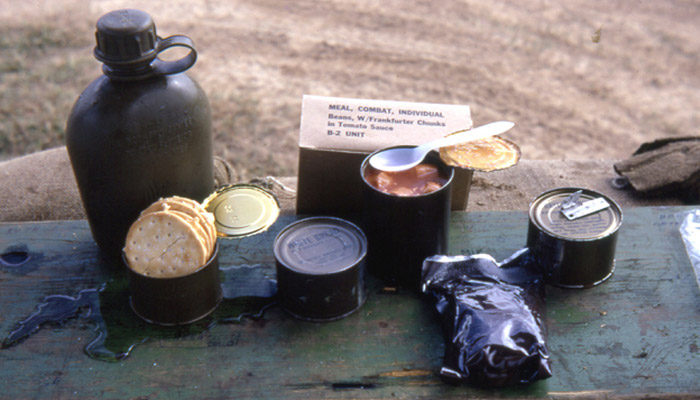
Soldiers in the Second World War would often eat out of bulky cans called C-Rations. That model continued into the Vietnam War era with MCI rations (“Meal, Combat, Individual”).
Vietnam catalyzed many changes in the military, and the US Army realized they needed a better ration for deep reconnaissance missions.
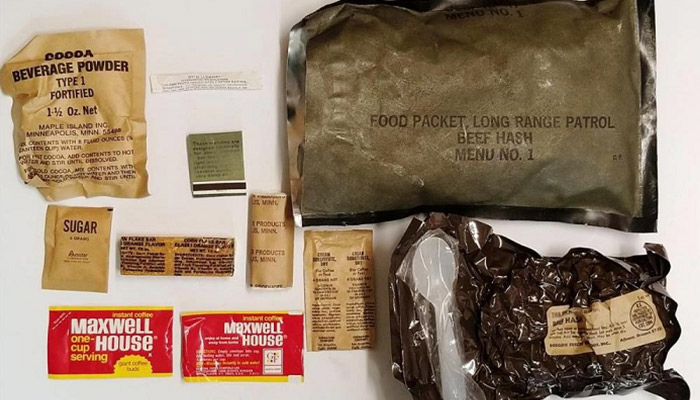
The military first adopted the Long Range Patrol (LRP) ration, consisting of dehydrated food that required boiling water in the field.
As military needs and technology continued to evolve, what most people think of as a modern MRE was released in 1981 and became a standard in 1986. Since its release, the MRE has been continuously improved with flameless heaters, biodegradable components, beverage mixes, and more entree options to include.
What’s inside a MRE
One of the things that makes an MRE an MRE is the collection of multiple components inside the box, instead of just being one pouch of one type of food. Common components:
- Main entree
- Side dish
- Crackers or bread
- Peanut butter, jelly, or cheese spread
- Dessert or candy
- Chewing gum, mint, etc.
- Coffee powder, beverage mix, and bag (to pour into)
- Moist towelette, napkin, or toilet paper
- Salt, pepper, sugar, creamer, hot sauce
- Utensil, toothpick
- Flameless heater
- Matches
Let’s walk through breaking down an old Sopakco, in this case a military-issue version we bought from a gun show.
The first thing we noticed was the lack of a Julian date code on the main packaging. The packaging was otherwise in excellent condition.
When we first cracked open the packaging, we were greeted by a pleasant sugary aroma — which turned out to be from a puncture in the grape jelly spread packet that leaked onto the beverage powder mixture.
Despite the lack of an external Julian code (which in this case was actually why the military rejected the shipment), the individual components each had stamped codes showing it was made in the summer of 2016.
Where to buy MREs (and why you shouldn’t buy surplus)
Within the US, the Department of Defense buys their MREs from three vendors:
Civilians technically can’t buy military MREs — but all three of those companies make “military-grade” civilian products in parallel.
There are plenty of products that make their way into the market even though they started their life in the military.
Sometimes things “fall off the truck” or “wander off base”, while in other cases the military might hand out extras in a natural disaster or decide to unload an older stockpile. So the military might think “this is four years old, time to get rid of it” while a civilian would still be willing to keep it on hand for another few years.
That’s why the second-hand market is almost never a good idea — you just don’t know what that particular MRE went through. Even if it’s “only a year old”, it may have spent that year cooking in a 150-degree container in Iraq. Or the military may have rejected the batch because it didn’t have a Julian code or had some other flaw, which again are things you want to avoid. Or someone collected a bunch of freebies after a disaster and is trying to profit by reselling.
How long do MREs last?
MRE shelf life is not as great as you might expect — when people buy from unofficial sources like eBay, they often get frustrated when they receive a “new” MRE that has an expiration date only a year or three in the future.
According to US Army field manuals, MREs will last:
- 5 years if stored at 40 F (4 C)
- 3 years at 80 F (26 C)
- 6 months at 100 F (38 C)
Shelf life has actually decreased compared to the original MREs in the 1980s. The original versions used freeze-dried ingredients, which lasted longer but had other tradeoffs.
Although the military makes a point to not keep stock for more than five years or so, there isn’t a concrete answer about the maximum limit. There are anecdotal stories of people consuming MREs that are 10+ years old with no ill effect. There’s even a great YouTube channel where they open and eat very old MREs:
Storage tips
The best place to store MRE is a cool dark place with low moisture content. A plastic tote/tub in the basement is a common example.
MREs can be frozen, though thawing and refreezing over and over are not recommended. Frozen foods tend to create irregular shapes that can create sharp edges that will expand due to the water content. MRE packaging was designed to withstand 1,000 flexes, but freezing can increase the failure rate of the pouch.
If you want to freeze or refrigerate your MREs, throw them in your freezer and don’t touch them. Be mindful of what you stack on and around the MRE.
This leads to a practical problem when you want to store the MRE outside or in your vehicle. If you live in a climate that gets worse than 40-80 F during the year — keeping in mind that a car can get hotter than you expect — you have two choices:
- Don’t use an MRE at all
- Plan on rotating them much more often than normal
How to figure out when it was made
Most of the components in an MRE, including the main package, will have a printed or stamped four-digit Julian code. The first digit will run from 0 to 9, and the last three will go from 1 to 366. For example, the code 9365 means it was made the 365th day of 2020, or December 30, 2019.
Since the military wouldn’t keep MREs around for close to a decade anyway, they don’t run into a problem of “does that 9 mean 2009 or 2019?” — it’s just the closest year that ends with that number.
Confused? Use this excellent Julian Code Converter.
Sometimes Julian codes will have a letter, which indicates a batch designation from the manufacturer that you can ignore.
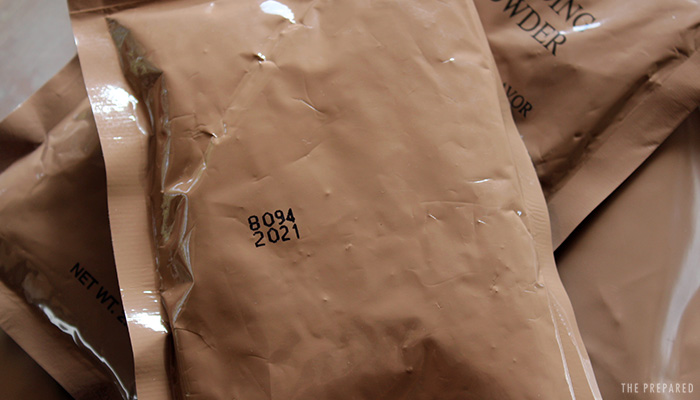
There may also be an inspection date. This is typically three years after the Julian date and identifies when MREs need to be inspected if they were in storage. A lot of sellers on eBay will advertise an inspection date and not the Julian date. If you buy MREs on eBay or Amazon, it is good to be aware of this for accurately dating an MRE. We recommend avoiding sellers that do not publish this data.
What happens if you are in a terrible situation and come across an old case?
Most of what you need to make a judgment call simply comes from paying attention to where you’ve found it: does it seem like it’s been in the same cool dry spot for years, or no?
According to the Defense Logistics Agency’s MRE Technical Data Package, pay attention to:
- Tears or holes in the packaging
- Swollen entrees or spreads
- Unusual odors
If your eyes and nose think it’s okay, but you’re still not sure, try eating a little bit and waiting to see if you feel ill. Note that aged food might have lost its color and flavor, yet may still give you nutrition.
If the food is spoiled, you may be able to MacGyver components like the heating bag, matches, seasoning, etc. while using the bad food as fish or trap bait.
Meals Ready to Eat are not meant for the long term
Ask any veteran if they’d like to survive on MREs for multiple days and you’ll likely hear jokes about constipation or diarrhea — these rations just aren’t meant for long-term sustenance.
According to the Army Field Feeding and Call 1 Operations (ATP 4-41/December 2015) Manual, MREs were designed to be eaten for no more than 21 days. The military conducts studies where they pay people to only eat MREs for weeks. The results showed a change in the participants microbiome, and other general “digestive unpleasantness,” reinforcing the 21 day guideline.
When soldiers have to eat MREs for more than 21 days, bread, fruit, vegetables, and milk are required as a supplementation.
If you are not actively running around trying to survive, you can spread your MRE meal throughout the day, and if possible, try to eat fruit and vegetables alongside your MRE.
If you happen to have or find a stash of MREs that you need to live on for a while, it’s helpful to supplement the lack of dietary fiber with supplements such as Metamucil and general multivitamins.
How do they taste?
Although we personally like them, many people hate the taste of MREs and what they can do to your digestive system over time. Here’s a fun taste test:
Special types
Besides options for those with special dietary needs, there are a few modifications for different environments and uses.
The Cold Weather Ration (or in military-speak: “Ration, Cold Weather”) are issued to troops operating in environments that would freeze a normal MRE. The main difference is the use of freeze-dried food with a higher calorie count.
A First Strike Ration is essentially three normal MREs put into one 2,900-calorie package that weighs 50% less than three individual meals. It’s designed for troops engaged in aggressive movement and combat, ie. they may only have time to sit and eat once per day. That might sound attractive, but the shelf life is only two years.
The Humanitarian Daily Ration is designed to provide one day of sustenance to a malnourished person — when someone is starving, you have to be careful about what food to give them as you bring them back up to normal. HDRs have zero animal products, save for a small amount of dairy, and have no alcohol ingredients. They usually come in a pink or yellow package.
